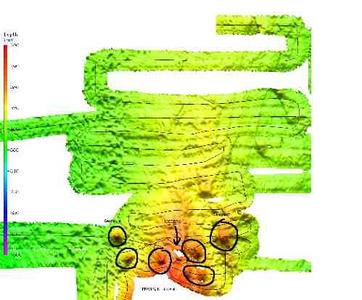29 January, 2004
The process of science is about inquiry, finding out new things about
the world around you. The past week or so we have been looking at
the seafloor with the sonar and seismic equipment and asking
questions about the things that we think we see from the preliminary
data. Today the scientists started to try and pose some answers to
the questions that they have been asking. After all the multibeam
surveys, and the beam editing, a preliminary map of the seafloor in
the area between B15A and B15K has been completed.
Of parcticular interest to the scientists is an area south of Franklin
Island that features a collection of seamounts. This area will
become the focus of survey work for the next day or so. Seamounts
are volcanic formations on the ocean floor that are formed as a
result of lava flows building volcanoes below the ocean surface. The
seamounts were approximately 250 meters in elevation, but the tallest
seamount was still more than 100 meters (310 feet) below the surface.
The seamounts are arranged in a cluster, all of similar elevation,
but of different steepness. We plan to collect rock samples from two
of the seamounts using a dredge as we had earlier in the cruise. One
of the dredges will be conducted this evening and the second tomorrow
morning.
Now that the scientists have focused their investigation, they will
look to add supportive data to their initial findings. More
attention will be paid to collecting magnetic data with the
magnetometer and bathymetric data using the "Simrad" system. The
magnetometer can supply some information about when and how the rocks
in the seamounts were formed.
All rocks contain elements that can be affected by the Earth's
magnetic field. The most common is Iron. When Iron is present in
molten lava or hot rock that has begun to solidify, the Iron atoms
are very free to move. Electrons in the atoms orient themselves in
the direction of the magnetic field, which in the case of these
seamounts is the magnetic field of the Earth. Over the Earth's
history, the magnetic field has changed directions, strength, and on
occasion the north and south magnetic poles have switched. When a
rock cools, it keeps a record of the direction of the Earth's
magnetic field at that time. Changes in the magnitude or direction
of the magnetic field strength of the rocks that make up the
seamounts give the scientists an indication of the volume of flows
that produced the volcanic formation over time and, when compared to
known times when the Earth's field switched from North to South
poles, some indication of the geologic age of the flows.
Many hands made fast work as the first dredge was brought on deck.
When they came up, the samples were mixed with thick muddy sediment
that had to be washed off of each rock individually. Following the
same procedure as the first dredge, rocks were selected and rinsed
with seawater and separated into groups of general and special
interest. Mud and sea creatures caught on the ride were squeegeed
over the side. The collection of rocks from this dredge was
substantially smaller than the first. This is not unusual, but was a
bit disappointing. Over the next few days Sam Mukasa will catalog
the rocks from the first two dredges to be taken to Michigan for
further analysis.
Sometimes the activities of the day cross over watch times making for
a long day, but the excitement of being the first one to see what
hits the deck out of the dredge is more important than sleep.
Special thanks to Dr. Terry Wilson for her editing and review this
entry, and her corrections and additions.

Map of the sea floor showing the seamounts that were located using the multibeam sidescan sonar. Seamounts are circled. The area in the center was not mapped because a large iceberg was grounded in there.

Collecting rocks from dredge 2.

Contact the TEA in the field at
.
If you cannot connect through your browser, copy the
TEA's e-mail address in the "To:" line of
your favorite e-mail package.
|
